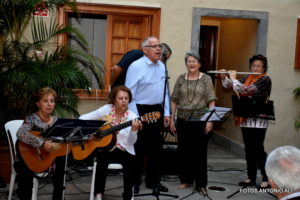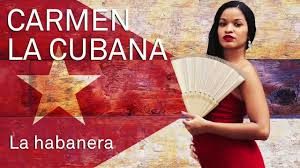EN CUBA durante el siglo XIX, el género musical La Habanera se convirtió en un acontecimiento importante, era la primera música escrita que se basa rítmicamente en un patrón de ritmo africano y la primera danza cubana en ganar popularidad internacional, al tiempo que era el progenitor del danzón, el mambo y el cha-cha-cha, que con sus característicos “ritmo de habanera” y letras cantadas llenaron un importante eslabon en la historia musical cubana. Eran esos momentos en que nacía nuestra nacionalidad, y fue un género que trascendio como expresión típica de lo criollo.
Fuera de Cuba, la contradanza cubana se hizo conocida como la habanera, el baile de La Habana, y ese nombre fue adoptado en la propia Cuba después de su popularidad internacional a fines del siglo XIX, aunque nunca fue llamado así por las personas que crearon.
La primera habanera de la cual se tiene noticias “El amor en el baile”, de autor anónimo, se entrenó en 1841. Divulgada por el periódico literario habanero La Prensa, el 13 de noviembre de 1842 la reseña refiere: “El amor en el baile, nueva canción habanera puesta en música con acompañamiento de piano”: Yo soy una niña muy bonita, / y el pesar no conocí; / yo soy niña, soy bonita, / y el pesar no conocí /.
La singular forma de cantar textos sencillos y la popularidad influyeron en la expansión del género, que se trasladó a América, España y el resto de Europa.
A su ritmo lento -60 pulsaciones por minuto- se suma la estructura simple y compas de 2/4, y emplea textos a base de versos octosílabos generalmente, en función de mantener su diseño formal.
LA HABANERA, ALIMENTO DE “LA MILONGA” ARGENTINA
El musicólogo argentino Carlos Vega encontró en el Cancionero musical de los siglos XV y XVI, un ejemplo que tenía el ritmo básico de la habanera. Hay influencia musical de este género en la milonga y el tango y alimentó a su vez los ritmos iniciales de casi toda América.
La milonga y el tango argentinos hacen uso del ritmo de habanera de un cuarto punteado seguido de tres corcheas, con un acento en la primera y tercera notas. Hasta cierto punto, el ritmo de la habanera se conserva en los primeros tangos, especialmente en El Choclo y “La Morocha” (1904). Como la base rítmica constante de la línea de bajo en el tango argentino, la habanera duró un tiempo relativamente corto hasta que una variación, notada por Roberts, comenzó a predominar.
En 1883, Ventura Lynch, una estudiante de bailes y folklore de Buenos Aires, observó que la milonga era “tan universal en los alrededores de la ciudad que es una pieza obligatoria en todos los bailes de clase baja (bailecitos de medio pelo), y … también ha sido retomado por los organilleros, que lo han arreglado para que suene como el baile de la habanera. Se baila en los clubes de baja vida … ”
Adornada y distribuida en toda la textura, la contradanza / habanera sigue siendo una parte esencial de la música del tango. “La trampera” de Aníbal Troilo, registrada por él en 1962, usa la misma habanera que se escucha en el Carmen de Bizet.
LA HABANERA EN EL AMBITO MUNDIAL.
El reconocimiento de que eran canciones llegadas de La Habana, produjo en España el cambio de estos nombres diversos por el gentilicio habanera. En tanto, muchos extranjeros buscaron en ese país novedades para sus composiciones, y utilizaron, precisamente, los ritmos y melodías de habaneras conocidas, tomadas de la música española: La ópera francesa Carmen (1875), de Bizet, pone en boca de la cigarrera Carmen una habanera que recorrió el mundo, como aria de ópera. La ópera francesa La habanera (1908), de Raúl Laparra, lleva hasta en el título el nombre del género. Otros renombrados músicos franceses, como Saëns, Chabrier, Lalo Auber, Fauré, Debussy y Ravel, junto a los españoles Sarasate, Albéniz y Falla, asumieron también la moderna habanera.
Después de 1860, el músico español Sebastián Iradier compuso “La paloma” quizás la más conocida en el ámbito internacional, una habanera probablemente inspirada en su etapa de estancia en La Habana, cuando impartió clases.
En cuanto a la influencia de la Habanera en la musica afroamericana, aunque es posible que nunca se conozcan los orígenes exactos de la sincopación del jazz, existe evidencia de que la habanera / tresillo estaba allí en su concepción. A Buddy Bolden, el primer músico de jazz conocido, se le atribuye la creación de “Los cuatro grandes”, un patrón basado en la habanera. Los cuatro grandes fueron el primer patrón de bombo sincopado que se desvió de la marcha estándar sobre el ritmo.
LA HABANERA CUBANA
A la influencia de autores españoles de zarzuelas también la recibieron artistas cubanos que crearon obras de temas, personajes y música nacionales. De ahí que aparecieran habaneras de Raimundo Valenzuela (La mulata Rosa); Ignacio Cervantes (El submarino); Manuel Pérez de la Presa (Los Saltimbanquis); José Marín Varona (El hijo del Camagüey); y en el Siglo XX Ernesto Lecuona (La Plaza de la Catedral) las cuales adquirieron altos vuelos en el contexto de la canción lírica cubana de fines del Siglo XIX e inicios del XX.
Ejemplo cumbre devino ‘Tú’ (1892) de Eduardo Sánchez de Fuentes, compositor cubano quien se destacó como el creador lírico más inspirado de ese género musical. ‘Mírame así’, de este autor constituye un exponente genuino estilo de danza vocal de expresivos ambiente cubano.
Otros compositores de la isla incorporaron las habaneras a sus zarzuelas, lo que también sucedió en Cuba con obras de músicos tan notables como Jorge Anckermann, Gonzalo Roig y Ernesto Lecuona.
Son reconocidas a nivel nacional e internacional Veinte años, de María Teresa Vera, Mariposita de primavera, de Miguel Matamoros y La rosa roja, de Oscar Hernández.
Si bien durante las primeras décadas del pasado siglo el género perdió vigencia en Cuba, como expresión contemporánea, no han faltado compositores y eventos que lo cultivan y propician su supervivencia en las células de muchas músicas de hoy en nuestro país y en España.
Liuba María Hevia es una de las artistas del patio que rindió tributo al género, en 1995 con una monografía sobre el género, Habaneras en el tiempo. En 2004 vuelve a grabar el propio disco titulándolo Ángel y habanera. Esta ocasión incluyó una canción escrita por ella que lleva el mismo nombre del disco y una de Silvio Rodríguez, “En el claro de la luna” que aspiran con admirable intencion de no dejar morír al género musical que llevó nuestra música alrededor del mundo.
 CUBAN MUSICAL GENRE “LA HABANERA” ITS INFLUENCE IN LA MILONGA, JAZZ, AND DANZÓN.
CUBAN MUSICAL GENRE “LA HABANERA” ITS INFLUENCE IN LA MILONGA, JAZZ, AND DANZÓN.
In Cuba during the 19th century, the musical genre La Habanera became an important event, it was the first written music that was rhythmically based on an African rhythm pattern and the first Cuban dance to gain international popularity, while it was the parent the danzón, the mambo and the cha-cha-cha, which with their characteristic “habanera rhythm” and sung lyrics filled an important link in Cuban musical history. Those were the moments in which our nationality was born, and it was a genre that transcended as a typical expression of the Creole.
Outside of Cuba, the Cuban contradanza became known as the habanera, the dance of Havana, and that name was adopted in Cuba itself after its international popularity at the end of the 19th century, although it was never called that by the people who created it.
The first habanera of which there is news “El Amor en el baile”, by an anonymous author, was trained in 1841. Published by the Havana literary newspaper La Prensa, on November 13, 1842, the review refers: “El Amor en el dance, new Havana song put on music with piano accompaniment ”: I am a very pretty girl, / and I did not know the regret; / I am a girl, I am pretty, / and the sorrow I did not know /.
The singular way of singing simple texts and popularity influenced the expansion of the genre, which moved to America, Spain and the rest of Europe.
At its slow pace, -60 beats per minute- the simple and compass structure of 2/4 is added, and it uses texts based on octosyllabic verses generally, in order to maintain its formal design.
LA HABANERA, INFLUENCE IN ARGENTINE “MILONGA”.
The Argentine musicologist Carlos Vega found in the Musical Songbook of the XV and XVI centuries, an example that had the basic rhythm of the habanera. There is the musical influence of this genre in milonga and tango and in turn fueled the initial rhythms of almost all of America.
Argentine milonga and tango make use of the habanera rhythm of a dotted quarter followed by three eighth notes, with an accent on the first and third notes. To a certain extent, the rhythm of the habanera is preserved in the first tangos, especially in El Choclo and “La Morocha” (1904). As the steady rhythmic base of the bass line in Argentine tango, the habanera lasted a relatively short time until a variation, noted by Roberts, began to predominate.
In 1883, Ventura Lynch, a dance and folklore student from Buenos Aires, observed that the milonga was “so universal in the surroundings of the city that it is a compulsory piece in all low-class dances (little half-length dances), and … it has also been taken up by the organ grinders, who have arranged it to sound like the habanera dance. It is danced in low-life clubs … ”
Decorated and distributed throughout the texture, the contradanza/habanera continues to be an essential part of tango music. “La trampera” by Aníbal Troilo, recorded by him in 1962, uses the same habanera heard in Bizet’s Carmen.
The recognition that they were songs arrived from Havana, produced in Spain the change of these diverse names by the name of Havana. Meanwhile, many foreigners in that country looked for novelties for their compositions, and they used, precisely, the rhythms and melodies of well-known Havanans, taken from Spanish music: The French opera Carmen (1875), by Bizet, puts the cigar maker in the mouth Carmen, a habanera who traveled the world, as an opera aria. The French opera La habanera (1908), by Raúl Laparra, even carries the genre’s name in the title. Other renowned French musicians, such as Saëns, Chabrier, Lalo Auber, Fauré, Debussy and Ravel, along with the Spaniards Sarasate, Albéniz and Falla, also assumed modern Havana.
After 1860, the Spanish musician Sebastián Iradier composed “La Paloma” perhaps the best known in the international arena, a habanera probably inspired by her time in Havana, when she taught.
As for the influence of Habanera on African American music, although the exact origins of jazz syncopation may never be known, there is evidence that the habanera/tresillo was there at its conception. Buddy Bolden, the first known jazz musician, is credited with creating “The Big Four,” a pattern based on the habanera. The Big Four were the first syncopated kick pattern to deviate from the standard gear over the beat.
THE CUBAN HAVANERA
The influence of Spanish authors of zarzuelas was also received by Cuban artists who created works of national themes, characters, and music. Hence, Havana’s Raimundo Valenzuela (La mulata Rosa) appeared; Ignacio Cervantes (The submarine); Manuel Pérez de la Presa (Los Saltimbanquis); José Marín Varona (The son of Camagüey); and in the 20th century Ernesto Lecuona (La Plaza de la Catedral) which acquired high flights in the context of the Cuban lyrical song of the late 19th century and early 20th.
Summit example became ‘You’ (1892) by Eduardo Sánchez de Fuentes, a Cuban composer who stood out as the most inspired lyrical creator of that musical genre. ‘Mírame thus’, by this author constitutes a genuine exponent of vocal dance style in an expressive Cuban atmosphere.
Other composers on the island incorporated habaneras into their zarzuelas, which also happened in Cuba with works by such notable musicians as Jorge Ackermann, Gonzalo Roig, and Ernesto Lecuona.
Twenty years, by María Teresa Vera, Mariposita de primavera, by Miguel Matamoros and La rosa roja, by Oscar Hernández, are recognized nationally and internationally.
Although during the first decades of the last century the genre lost validity in Cuba, as a contemporary expression, composers and events have not been lacking that cultivate it and promote its survival in the cells of many pieces of music today in our country and in Spain.
Liuba María Hevia is one of the patio artists who paid tribute to the genre, in 1995 with a monograph on the genre, Habaneras en el Tiempo. In 2004 he recorded the album again, titled Ángel y habanera. This occasion included a song written by her that bears the same name on the album and one by Silvio Rodríguez, “In the moonlight” that they aspire with a good intention of not letting the musical genre that took our music around the world die.
Agencies/ RHC/ Guadalupe Yaujar/ Maite Gonzalez/ Extractos/ Excerpts/ Internet Photos/ YouYube/ Arnoldo Varona/ www.theCubanHistory.com
THE CUBAN HISTORY, HOLLYWOOD.









